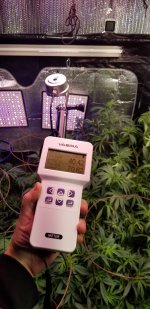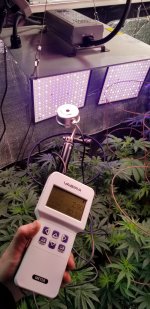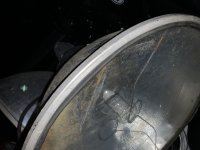Just call me mr ButterfingersHoly shit rocketsoul, UHF, ah the memories. Before kramer was kramer..... MY MOP
-
ICMag with help from Phlizon, Landrace Warden and The Vault is running a NEW contest for Christmas! You can check it here. Prizes are: full spectrum led light, seeds & forum premium access. Come join in!
You are using an out of date browser. It may not display this or other websites correctly.
You should upgrade or use an alternative browser.
You should upgrade or use an alternative browser.
LED and BUD QUALITY
- Thread starter Tropical Sun
- Start date
In probably all cases. The higher you go, the thinner the atmosphere, the more UV gets through. There is something like a 10% increase in UV for every 1000m of altitude, all else being equal.An in some cases we can also add altitude as a variable factor to sunlight as well
If I had to go HID I would choose 3000K CMH. If you look at the LED spectrum I created, it is close to CMH in many respects, just more efficient, more red and less green.Indeed the CMH is really looking close to the sun is it the 3000 k or the 4000 k bulb. But what would u choose besiddes aussie light LEDsome still use mh/cmh/hps in coolder times.
Fyi massmedical insta is goin hot , and it's not only in a positive way, People seems tired of his light "bashing talk"...
CMH, IMO, has a nice balance of everything. I even developed a LED spectrum to compliment it – specifically designed to mix LED and CMH together to get the UV and broad-spectrum Far Red (CMH) with more red and less blue/green.
Here it is:
When mixed with CMH (I've posted this already):
Here is the LED panel (around 2700-2800K):
And here are some plants grown under it from about 5-6 years ago:
Plants love red light. And they love far red light. Incidentally, that High Red LED spectrum was CRI95, which is why it looks so crisp and white in the photo above, even though it is 2700-2800K CCT.
All I see when I study that Mass MH spectrum chart is all the wasted IR in the 750+nm range. Does 750+nm IR have some specific quality that plants want or need – apart from metabolic warmth (kinetic energy that speeds up organic chemical processes)?
If they do, then I would love to see the studies.
And for anyone wondering about this themselves, just have a look at how much IR the HPS produces in the same range. The main difference – because they both emit IR in the same range – is the proportion of IR to FR, UV and visible light.
There's not even a correlation between IR and leaf temperature!
Don't believe me? See below . . .
My main concern is the fact the Mass MH produces far more IR than even the sun when you look at it as a proportion of electro-magnetic radiation. Plants can't use that IR (as far as we know) to photosynthesise, so what value does it have outside of providing extra warmth when needed? And what if you already have a warm grow room and don't need the extra heat?
And LED actually contributes to higher leaf temperatures than sunlight! Again, I have posted this before. Indeed, LED has the same linear leaf temperature gradient as sunlight, just two degrees higher at all points.
You can see how useful HPS can be to adding warmth and if you're wondering why sunlight results in lower leaf temps than ambient, then that's a function of blue-light stomatal opening. So most of that extra IR in the Mass MH is probably going to waste anyway, because all the blue light and UV is triggering stomatal opening that cools the plant through transpiration (evaporation and CO2/O2 exchange at the leaf surface).
So ive finally got a way to share some bud pics of our results 
@Piecho helped me with some pics and close ups of our latest testers. These were grown under heavily supplemented high cri/low K horticentric spectrum. We usually get more chunky buds but messed up the first run, these ones are quicker finishers so our ramp up of nutes and light missed them by about a week or so: we got much less great bud than what we would have liked but it was 3 strains with no previous experience on how they flower. But that "quality" look is 100% there; hairy, shiny and oozy. Maybe even a bit over ripe.
Pics in this post and a few posts up:
If you like them show some love to Piechos photography in his thread
@Piecho helped me with some pics and close ups of our latest testers. These were grown under heavily supplemented high cri/low K horticentric spectrum. We usually get more chunky buds but messed up the first run, these ones are quicker finishers so our ramp up of nutes and light missed them by about a week or so: we got much less great bud than what we would have liked but it was 3 strains with no previous experience on how they flower. But that "quality" look is 100% there; hairy, shiny and oozy. Maybe even a bit over ripe.
Pics in this post and a few posts up:
If you like them show some love to Piechos photography in his thread
Mr.NotSoFast
Member
macro pics from dry nugs:




Ca++
Well-known member
Pssst. Light can drive transpiration, without heat gain. In fact, light can dry a surface, and the water leaving will take heat from it's surroundings. So the net effect is cooling.

 news.mit.edu
This could mean green lasers are in our future. It actually opens up a lot of things to think about again. Though I'm lacking quantification, it is happening.
news.mit.edu
This could mean green lasers are in our future. It actually opens up a lot of things to think about again. Though I'm lacking quantification, it is happening.

How light can vaporize water without the need for heat
MIT researchers discovered that light can cause evaporation of water from a surface without the need for heat. This “photomolecular effect” could be important for understanding climate change and for improving some industrial processes.
Indeed.Pssst. Light can drive transpiration, without heat gain. In fact, light can dry a surface, and the water leaving will take heat from it's surroundings. So the net effect is cooling.
Just blabbing here... an see if my approach falls in line with any other readers thoughts. I often have no one to bounce these ideas, thoughts, or approaches off of.
not about green lasers, but the first part of your post.
been messing with my laser thermometer to get leaf surface temperature for awhile now. Before i had the PPFD meter installed on the hydrox pro, and even still today, this was one of the best tools to see if the leds where in the sweet spot. Or am i driving the plants to hard?
It still really is a great tool, u don't have to climb in to the trellis, just point the laser an shoot. An see if you need to adjust the light.
Or maybe the laser temps shows you that this corner of the room is hotter, maybe that's telling me there's less air flow over here, so lets add another low speed fan to move air a little more air over here, etc etc. An see if that corrects the LST. If not, then the light intensity should be lowered, or raise the light. 16 inches above the majority of the canopy seems to be my setups sweet spot.
there is always, always, a domino effect.
My approach was to watch the leaf surface temps, AFTER, you know the plants are fully awake and transpiring, then compare to current room temps. The industry standard with co2, from what i gathered was u should not see more then a 2 degree over room temps. If you do, an your pretty much sure your environment is correct, u need to make a light change cause for one reason or another, you are over driving your plants.
u can see a negative temp or a 3 to 4 deg f OVER room temps on some upper colas, then other areas that are transpiring heavier u could see a 2 to 4deg F LOWER. the next cola over could vary abit
By doing this i seen a direct connection to leaf health. This would tell me that i should higher or lower the light bars, or higher or lower the output % on the light. then recheck later on when maybe the plant canopy is a little more mature.
this also plays into saving electricity, lowering light strength when over driving the plants, forming a healthier plant over all. Or baking off terps. then with monitoring my mediums water content, i can see what the plants are doing.
When viewing the 24hr water content, an seeing the normal over night dry down slope on the graph, after about an hour & half or so of the lights being on, the water content meter starts to shows an increase of water removal from the medium.
How i perceive that info is kind like how we wake up in the morning too. it takes a little bit to get moving. so why hit them with to much light if its not being utilized properly. The light is the driver, but it takes a little bit for all the plants systems to come back on line that are associated with daylight activity.
Then i know the plants are awake and starting to transpire and move faster. i can then adopt a light pattern that increases from sunrise to a higher light intensity at a solar noon, then a heavier lite afternoon (compared to morning, they where waking up the first 2 hrs of the day), then a shorter sunset.
then throw in symptoms like your upper leaf is deficient in one way or another, and your canopy 6 inches below that line is perfect.
*** edit**
another indicator was leaf transparency. from below the fan leaf, looking up, seeing the lime green empty voids in the leaf margins. or is the margin dark and block light.
transparency seems to me a lack of atp or associated energy reserves that are missing. calcium, mag, thinner cells , low brix, and everything else associated. Over driving the light compared to the plants current ability to replace anything associated within its energy cycle. Lower the light intensity an or improve nutrient strategy to get the leaf thick an healthy again.
Then the disease cycles that unhealthy leaf or plant brings on. Not to mention now its an inefficent "Machine". 80-84f an around 1.0 vpd seems to be the sweet spot. hard veg will be the upper temp of that range 82 an even 85 86. then a little lower vpd after budset
Last edited:
Ca++
Well-known member
I saw a couple of UV LEDs on a spectrometer recently. Both had interesting IR peaks, that were unexpected. That's not a wide study by any measure, but it did make me think about the results of using these UV LEDs, and how we might see it as a UV test, and ignore the IR addition.
Shhhh! Secret sauceI saw a couple of UV LEDs on a spectrometer recently. Both had interesting IR peaks, that were unexpected. That's not a wide study by any measure, but it did make me think about the results of using these UV LEDs, and how we might see it as a UV test, and ignore the IR addition.
They all have it. Here is the Nichia 405 we use – it has 5% deep far red.
Here is our old "PC Blue", which is 1x405nm + 2x420nm dies in one package (chip) with a blue phosphor:
greyfader
Well-known member
really nice flower expansion! what are those lights?Did some short veg sog from seed with good results under led. Staten island chem s1s in foreground. I think even snakedope would get faded off this shit.
It's fun to actually measure the lights. These are 2 Finnchy lights. 125 watt, and 250 watt. with the UV / Red switches, ON. it was interesting to see how extra-hot the diodes were on the smaller board. I'm really close on some of those, after I accidently burnt a polyester hoodie last winter.
I would have liked for this meter to break things down a bit more. but it's basically everything outside the PAR range of 400nm-700nm. UV <400, and Reds <700.
I use UVB T5 lights near the end of flowering, and some far reds/IR's, and some UVA LED lights.
I would have liked for this meter to break things down a bit more. but it's basically everything outside the PAR range of 400nm-700nm. UV <400, and Reds <700.
I use UVB T5 lights near the end of flowering, and some far reds/IR's, and some UVA LED lights.
Attachments
-
 finnchy1.jpg196.6 KB · Views: 49
finnchy1.jpg196.6 KB · Views: 49 -
 finnchy2.jpg199.1 KB · Views: 42
finnchy2.jpg199.1 KB · Views: 42 -
 20240103_UV4_Finnchy250.jpg1 MB · Views: 40
20240103_UV4_Finnchy250.jpg1 MB · Views: 40 -
 20240103_UV9_Finnchy250w.jpg1.1 MB · Views: 40
20240103_UV9_Finnchy250w.jpg1.1 MB · Views: 40 -
 20240103_UV12_Finnchy125w_1.jpg977.1 KB · Views: 39
20240103_UV12_Finnchy125w_1.jpg977.1 KB · Views: 39 -
 20240103__Finnchy125w_2.jpg1.2 MB · Views: 40
20240103__Finnchy125w_2.jpg1.2 MB · Views: 40 -
 20240103_UV13__Finnchy125w_3.jpg481.1 KB · Views: 38
20240103_UV13__Finnchy125w_3.jpg481.1 KB · Views: 38 -
 20240103_UV14__Finnchy125w_4.jpg1.4 MB · Views: 42
20240103_UV14__Finnchy125w_4.jpg1.4 MB · Views: 42
The manual of my fixture says to place the bars as close as 15cm from the tops but I never dared to place it this close, I have used HPS for so long I have a hard time putting the light so close to the plants. I was thinking of your other pic where the tops are almost touching the LED, it doesn't stress them this proximity ?Then what's the stats of yours to be used this close of the plants?
I have a 2,9umol light with 1400ppfd max output.
CannaT
starin' at the world through my rearview
With higher amount of IR plants can touch the led board...this led "light burn" is more caused by inpropriate light spectrum than it is with powerfull lights levels.The manual of my fixture says to place the bars as close as 15cm from the tops but I never dared to place it this close, I have used HPS for so long I have a hard time putting the light so close to the plants. I was thinking of your other pic where the tops are almost touching the LED, it doesn't stress them this proximity ?
Leds are good for veg and thats all....I have to say that I never had that speed of veg growth since I moved led from flower to veg.
When plant dont have IR its like its is blind.
Phytochrome System: Phytochromes can detect the ratio between red light (around 660 nm) and far-red light (around 730 nm), which is near the infrared spectrum. This ratio changes depending on whether the plant is in the shade of other plants (where there is more far-red light) or in open light (where there is more red light).Growth and Shading: Through the phytochrome system, plants can detect the presence of other plants nearby and respond to shading. For example, when a plant detects an increase in far-red light, it may indicate that it is shaded by other plants, triggering stem elongation to reach better-lit areas.Photomorphogenesis and Adaptation: This detection and response to different parts of the light spectrum help plants adjust their growth processes and survival strategies, such as changing the shape, size, and arrangement of leaves to maximize light use efficiency.Environmental Assessment: Infrared light, along with other parts of the spectrum, allows plants to assess their environment and make necessary adjustments in growth and development to optimize resource utilization.Conclusion: Infrared radiation indeed serves as an orienting signal for plants, enabling them to evaluate their surroundings and adjust their growth and development strategies to optimize the use of available resources. This capacity is crucial for their survival and efficiency in various environmental conditions.
Make yourself a favour and use HPS in flower.
I Care
Well-known member
greyfader
Well-known member
wow, that viagra meter looks promising! does it show the angle of the dangle?It's fun to actually measure the lights. These are 2 Finnchy lights. 125 watt, and 250 watt. with the UV / Red switches, ON. it was interesting to see how extra-hot the diodes were on the smaller board. I'm really close on some of those, after I accidently burnt a polyester hoodie last winter.
I would have liked for this meter to break things down a bit more. but it's basically everything outside the PAR range of 400nm-700nm. UV <400, and Reds <700.
I use UVB T5 lights near the end of flowering, and some far reds/IR's, and some UVA LED lights.
Last edited:
greyfader
Well-known member
as a famous cheap bastard, i approve of using anything that will grow weed. but, do you know how to wire a 240v ballast to a 120 circuit? it looks like there is a ballast on it. does it say what voltage to use?I think at some point I brought up the hps Spectrum mogul base bulbs. Well I found some 1000w MH domes in a free pile, now I’ve gotta come up some extra pocket money for bulbs. Then wire the domes up to wall plugs. Should be interesting!!
i don't remember any warehouse lights that run on 120v. but there is a way to get 240v by wiring together 2 separate 120v outlets to produce a 240v circuit.
what's the brand and diameter of that thing?




